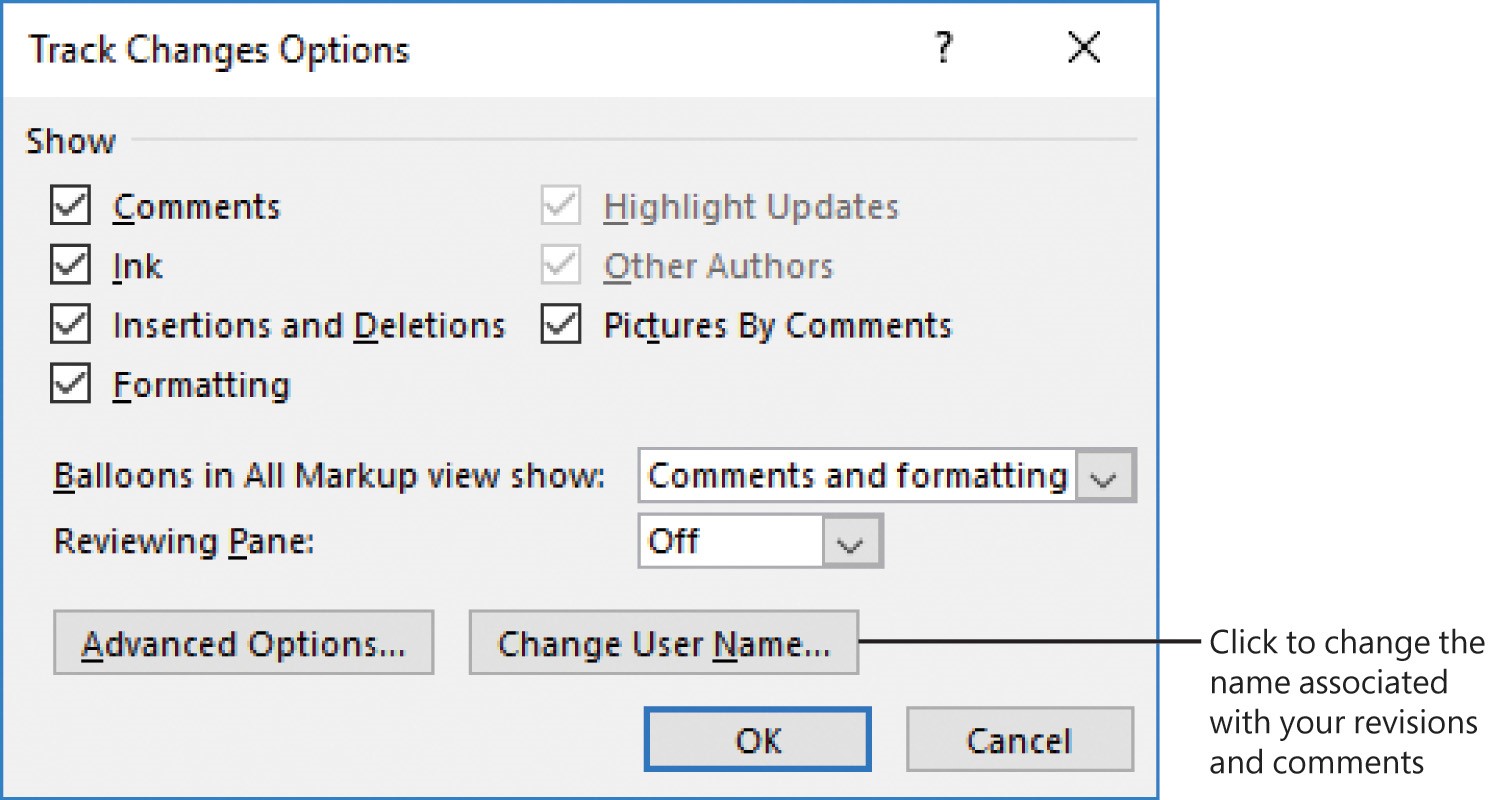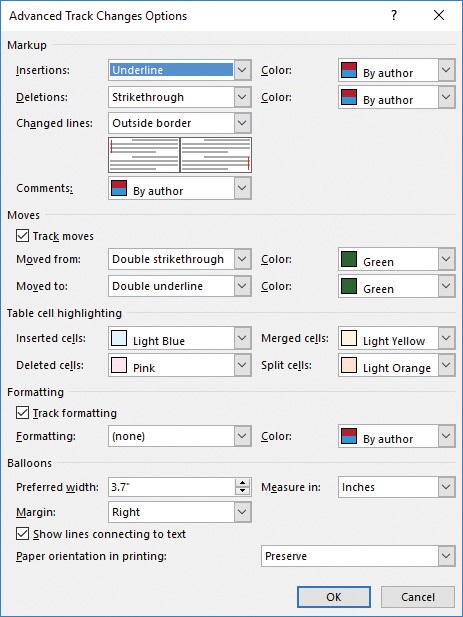Objective 1.3: Manage Document Changes
- 1.3.1 Track changes.
- 1.3.2 Manage tracked changes.
- 1.3.3 Lock or unlock tracking.
- 1.3.4 Add comments.
- 1.3.5 Manage comments.
OBJECTIVE 1.3: Contents
1.3.1 Track changes.
Manage change tracking
The Track Changes command on the Review tab turns on or off the change-tracking feature. When change tracking is turned on, Word records insertions and deletions made to the current document’s text, indicates where text was moved, and marks changes to formatting.
You can set options for how Word displays tracked changes, and you can hide changes when you want to view a document in its altered or original state.
You do not need to turn on change tracking each time you open a document. After you turn on the feature, Word tracks changes to the document until you or another user turns the feature off.
Important: The password you define to lock change tracking does not secure the document against malicious users. It does not encrypt the document, for example. For more information, see “Objective 1.2: “Prepare documents for review.”
As you revise and review a document with change tracking turned on, you can use tools in the Tracking group on the Review tab to change the view of a document to read it with more or less of the markup displayed. By using the Show Markup menu, for example, you can turn on or off the display of insertions and deletions, formatting changes, or comments. By selecting an option from the Display For Review list, you can view the document as though all revisions were accepted or as it was initially written.
See Also: For more information about viewing markup and setting markup options, see “Manage markup options” later in this topic.
Tracking revisions that you and other users make to a document can be simple and straightforward. When you click Track Changes on the Review tab, Word tracks the insertions, deletions, text moves, and formatting changes you make to the document. When you review the revised document, you can use commands in the Changes group on the Review tab to locate revisions and then accept or reject them.
You can also apply one or more options for how the program tracks and displays revisions and how you view them. In the Track Changes Options dialog box, use the check boxes in the Show area to specify which changes to a document you want to display as you work on the document. These options include Comments, Ink, Insertions And Deletions, Formatting, and others. You can also specify what information Word displays in balloons that appear along the side of a document in specific views. You can use balloons to view each revision or to view only comments and formatting changes. You can choose an option (Nothing) to view all changes inline. If you select Comments And Formatting, Word displays insertions and deletions in line within the document’s text.

Select the changes to display inline and in balloons
Tip
Changes you make to a document are identified by the user name and initials shown in the Word Options dialog box. (The default user name and initials are created when you install Office.) For some documents, you might want to be identified by your role or with a user name other than the one currently set. For example, you might want to associate revisions with the name of your department if you are reviewing a document on the department’s behalf. Click Change User Name in the Track Changes Options dialog box, and then enter the user name and initials you want to use. You also need to select the option Always Use These Values Regardless Of Sign In To Office—otherwise, comments will always be identified by using the name associated with your account. Any change you make to your user name and initials or to the setting for the Always Use These Values Regardless Of Sign In To Office option is carried over to other documents and to other Office programs. You should revert to your standard user name when you want to use it again.
The Advanced Options button in the Track Changes Options dialog box opens a dialog box where you can specify additional settings for how changes are tracked and displayed.

Advanced options include formatting of insertions and deletions and whether to track text movement and formatting changes
In this dialog box, you can do the following:
- Select the formatting that Word applies to insertions and deletions. By default, Word underlines insertions and uses strikethrough formatting to identify deletions. Other settings include Bold, Italic, Double Underline, and Color Only.
- Specify where Word places a line that indicates where a change was made. The default setting is Outside Border. Other settings are Right Border, Left Border, and None.
- Select a color to identify your changes. By default, Word uses the By Author setting, which means that Word assigns a color to each reviewer. You can select a specific color in which to display your changes.
- Select a background color for comment balloons.
- Specify whether Word tracks text that is moved. You can select the formatting (including the color) that Word applies to moved text in its original and new locations. If you clear the Track Moves check box, Word treats moved text as it does deletions and insertions.
- Set options for how changes to table cells are highlighted.
- Specify whether to track changes to formatting and how Word displays those changes.
- Specify the size and position of comment balloons. You can also specify whether Word shows a line that connects a balloon to the text it refers to.
- Specify how Word orients the page when you print a document with revisions and comments.
To turn change tracking on or off
![]() On the Review tab, in the Tracking group, click the Track Changes button.
On the Review tab, in the Tracking group, click the Track Changes button.
![]() On the Review tab, in the Tracking group, click the Track Changes arrow, and then click Track Changes.
On the Review tab, in the Tracking group, click the Track Changes arrow, and then click Track Changes.
![]() Press Ctrl+Shift+E.
Press Ctrl+Shift+E.
To set tracking options
1. On the Review tab, in the Tracking group, click the dialog box launcher.
2. In the Track Changes Options dialog box, do the following:
a. In the Show section, select the check boxes of the types of changes you want Word to display as you work on the document.
b. In the Balloons in All Markup view show list, click the information you want Word to display in balloons.
c. In the Reviewing Pane list, click Off or On to indicate whether to display the Reviewing pane.
3. Click Advanced Options. In the Advanced Track Changes Options dialog box, do the following:
a. If you don’t want Word to track text movement, clear the Track moves check box.
b. If you don’t want Word to track formatting changes, clear the Track formatting check box.
c. In each active list, click the formatting you want to assign to that type of change tracking.
4. Click OK in each of the open dialog boxes.